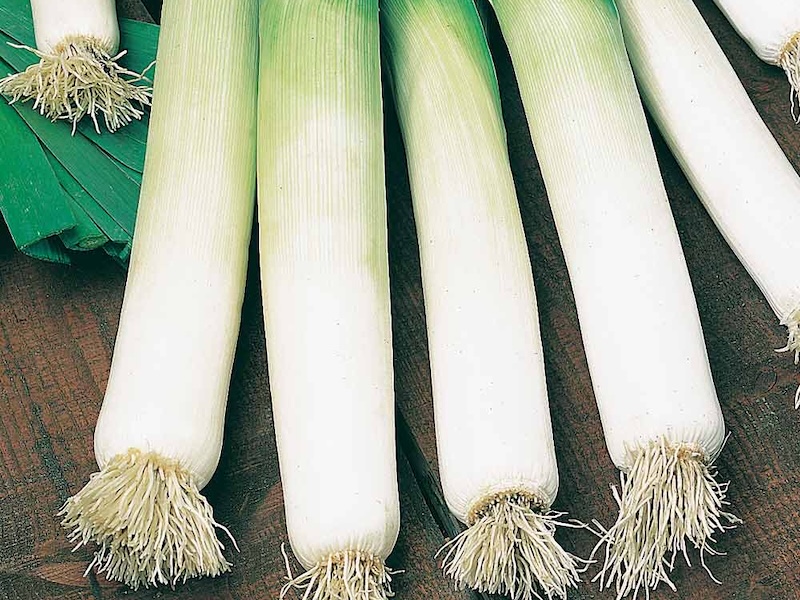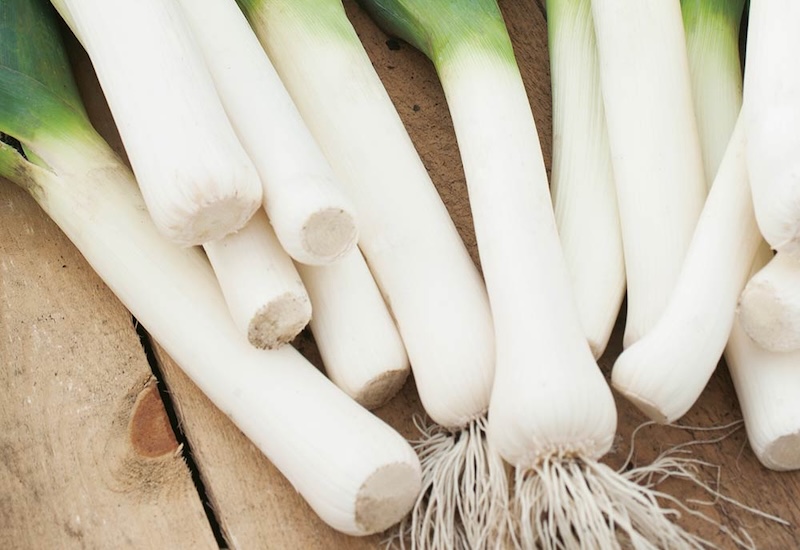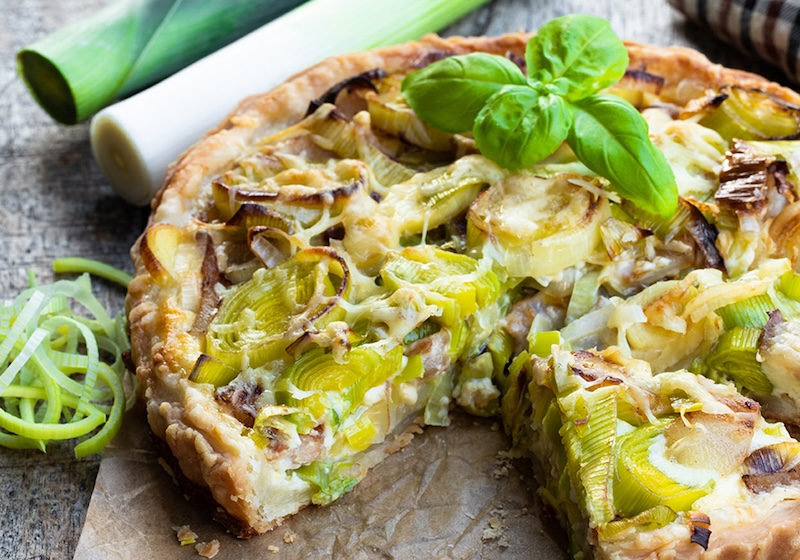Leeks are easy to grow from seed, and provide a versatile crop that can be braised, roasted, grilled, steamed, sautéed, stir-fried or added to soups and stews. You can even grow leeks in a large container. We asked experienced allotment grower Lee Senior to share his expert advice on growing this tasty member of the onion family. Here are his top tips for successfully growing leeks.
Want to give it a go? Browse our full range of leek seeds.
How to choose the best leek varieties to grow
When choosing the best varieties for your allotment or vegetable patch there are two key things to consider. The first is the location. Some leeks are hardier than others and Autumn varieties are generally a little less cold tolerant.
The second consideration is the length of the cropping season that you require. With careful planning it’s quite possible to be harvesting from late September through until Easter, giving a wonderful six months of cropping if you love your leeks!
- For an early-cropping autumn variety look no further than Leek ‘Blue Green Autumn Neptune’.
- For sheer winter-hardiness and reliability, nothing beats the time-served Leek ‘Musselburgh’. This variety crops throughout the mainstay of winter from the end of November until early March.
- For a late cropper, I like the aptly-named variety ‘Northern Lights’. The leaves of this leek, while not quite as spectacular as the real thing, change colour from green to purple as winter progresses. More importantly, it stands well and can be harvested as late as the end of April.
Sowing leek seeds indoors

High yielding and rust resistant, ‘Blue Green Autumn Neptune’ is winter hardy
Image: Leek ‘Blue Green Autumn Neptune’ Seeds from Suttons
Leeks require a long growing season for the shanks to reach a decent thickness. The time from seed sowing to cropping mature-sized vegetables is 28-32 weeks, depending on the variety.
Over the years, I’ve tended to sow the majority of leek seeds indoors in a cold greenhouse. From a late February or early March sowing, the sun can be warm enough to provide sufficient temperatures for reliable germination. Alternatively, if the weather is still wintery, use a heated propagator or warm windowsill to provide the required 12-18C (54-65F) temperature. Germination takes about 14-21 days.
If you’re growing exhibition leeks the sowing time is even earlier, from mid-January to early February. These need a longer season to develop to a greater size. Here are my tips for sowing under cover:
- Fill small pots, modules or deep seed trays with multipurpose or seed compost.
- Sow the seeds thinly and shallowly to a depth of 15mm (half an inch).
- Lightly cover them with compost or perlite and gently firm.
- After germination, grow the seedlings on by keeping them cool and out of too much direct spring sunlight.
- Slow and steady development of the young plants is what you’re after. Try to keep them moist at all times.
- Harden the young plants off before planting them out in their final growing positions at the end of May.
Sowing leek seeds outdoors
 This unusual variety changes from green to purple during winter
This unusual variety changes from green to purple during winter
Image: Leek ‘Northern Lights’ F1 Seeds from Suttons
There’s no point sowing seeds too early in the year when the soil is still cold and germination will be erratic. Outdoor-sown leeks often mature a little later than plants started off indoors, so a combination of both indoor and outdoor sowings can be useful.
If the weather is good and you have the space, leeks can be direct sown where you want them to grow once the soil warms up at the beginning of April. Alternatively, you can start them in a seed bed. Here are my tips for sowing leek seeds outdoors:
- Prepare and rake the soil to a fine tilth.
- Sow the seed thinly in a seed drill lined with multipurpose compost at a depth of 15mm (half an inch).
- Water the drill before sowing if the soil is dry.
- Lightly cover the seed drill, with fine soil, lightly firming as you go. I’ve found it’s well worth covering the seed drill with a portable cloche or fleece to aid germination and protect from any cold conditions.
- Germination takes around 18-21 days depending on the weather. This could be longer if cold weather strikes.
- Gradually thin the seedlings to around 20cm (8in) apart and around the thickness of a pencil. The thinnings can be used for transplanting to make new rows. Alternatively they can be used in salads or treated as baby leeks or slightly larger spring onions!
- Leeks can also be grown outdoors in a seedbed at the beginning of April and then transplanted to their final growing positions. This alleviates the need for hardening off the seedlings.
Seed tapes are a great alternative way to grow leeks. They’re also a good way to get a long cropping season as they contain varieties that mature at different times. Suttons 6m leek seed tape contains a multitude of different varieties including ‘Musselburgh’, ‘Neptune’ and ‘Porbella’. The tapes can be used from early to late April and are completely fuss-free. Choose a sunny or semi-shaded spot where the soil has been prepared to a fine tilth. Simply make a small groove and water well before carefully rolling out the tape and cutting to length. Lightly cover the tape and ensure it doesn’t dry out.
Planting leeks out into their final position

‘Below Zero’ is one of the hardiest varieties you can grow
Image: Leek F1 ‘Below Zero’ Seeds from Suttons
The best technique for planting out leeks is a topic that can divide opinion, and many allotment holders have a unique way that works for them. Your preferred way may differ slightly from your allotment neighbour, but that’s fine if it works for you! Here’s how I plant my seedlings out:
- Choose a sunny site, although leeks can cope with semi-shade.
- If you’re growing more than one row, allow 30cm (12in) between rows.
- Transplant the young plants when they’re around 15-20cms tall (6-8 inches).
- Make a hole around 15cms (6 inches) deep with a dibber or your finger.
- Carefully drop the plant inside the hole and spread the roots. Most importantly, fill the hole with water to allow the roots to settle.
- Some growers backfill the holes themselves with soil, as I do, while others leave them to fill naturally over time. Leave the top 8cms (3 inches) of the young leek above the top of the hole. This helps you to get plenty of the tasty white blanched stem that all leek-growers strive for.
How to care for leeks

This variety has long pale shanks and good resistance to leek rust
Image: Leek F1 ‘Sprintan’ Seeds from Suttons
Leeks aren’t difficult to grow, as long as good basic garden husbandry is employed. They prefer a well-drained, humus-rich soil containing plenty of rotted organic matter. Try to choose a part of your allotment that hasn’t grown leeks or alliums for several years. If you want long, blanched stems, mound up the soil around each plant in the second half of summer.
Keep an eye out for slugs and snails after transplanting your leeks. They don’t seem to be the number one favourite of those pesky molluscs, but they will take them in wet weather if there’s nothing else around.
Leeks dislike erratic moisture levels, especially when they’re newly transplanted. They also dislike cold spring weather and any checks to their growth. This can encourage the plants to bolt which is one of the most common problems. If the plants do start to bolt, the trick is to remove any flower spikes very early while they’re short and still in bud. If you don’t, the plants will go woody. If you catch and remove the flower spikes early enough, the rest of the leeks can be used as normal. (It’s worth noting that the young flowers are edible and have a delicate flavour.)
Rust is common on leeks, and wherever I’ve grown them it seems to follow me around! The so-called ‘rust’ is in fact a fungus. Those tell-tale orange spots are worse when leeks are grown too close together in damp, humid conditions. Although common in leeks and alliums, the rust is generally not destructive but looks unsightly. Try and choose resistant varieties where possible.
How to harvest and store leeks

This trio of leek varieties provides a long cropping season for use in the kitchen
Image: Leeks Seed Tape from Suttons
Leeks can be dug up gently using a fork underneath the plant. Simply loosen the soil, tease the roots out and shake off excess soil. If you have loamy or free-draining soils, they can also be harvested by hand by pulling and gently twisting. It must be said that occasionally they can snap as well, if you pull too fast, so do use this method with caution! I wouldn’t recommend it for heavier soils.
As leeks are essentially a winter crop, there may be times when you want to harvest from frozen soil. If this happens, it’s still possible to carefully dig them up using a spade in my experience. But if prolonged and severe frost is forecast, you could always dig up a few in advance and keep them in a container of soil in the garage to use in a few days’ time. Frost itself doesn’t harm the plants, in fact, it could be argued that it brings out the flavour.
Leeks can be stored in the fridge for a couple of weeks, although they will inevitably start to go a little softer over time.
We hope we’ve inspired you to try growing your own leeks from seed. Find more of Lee’s practical, hands-on, vegetable growing advice over at his monthly allotment pages.
Last Updated on December 11, 2024 by Suttons Horticultural Team



